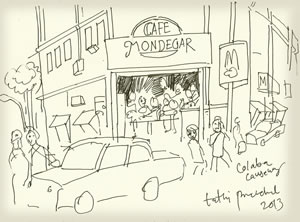For certain individuals, food is only a need to gratify their basic needs; for the others, however, food is something beyond a fundamental need, yet a joy that assumes a huge part in their comprehension of bliss. There is an ample number of cuisines and food inclinations worked by cultural foundations, topographical areas, and social classes. Food and mainstream meals can disclose to us a great deal about the history and conventions of different countries and locales. But the question is, what did our food resemble many years prior? In a time where no technology and social media existed, how would we know what our progenitors ate? The most appropriate response carries us down the lane of texts, communication the most enchanting form of knowing almost anything and everything, Art. Compositions down the ages have helped us give a brief look at what our eating table resembled. And a common love for food and art in today’s world has resulted in the mouth-watering and captivating portrayal of food that in some way or another characterizes an individual, his/her encounters, and experiences. Artists are bridging the gap between a mere drawing and the actual form and presence of the food with the hyper-realistic images of it. One often gets astonished upon an encounter with the works of Sarasvathy TK, whose paintings invite the viewers to indulge them and have a visual treat.
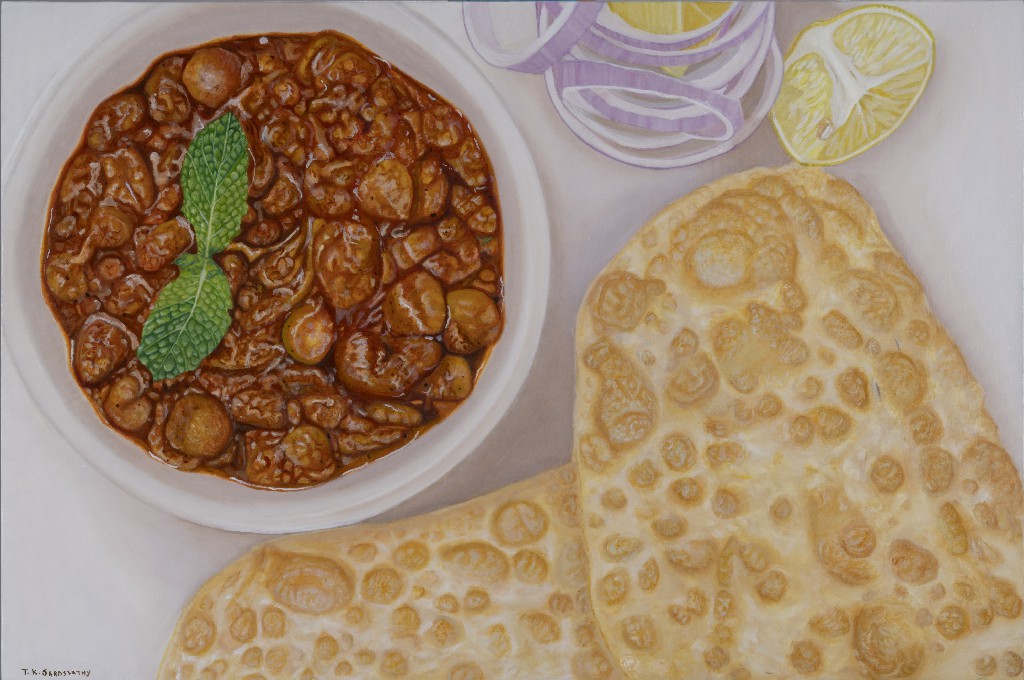 An artist from Chennai, India living in New Jersey, US, Sarasvathy’s immaculate renditions of Indian food connects with the viewer instantly. But her story is full of turns and twists and discoveries within the self. A Computer Science engineer at an early stage of her life, Sarasvathy was inclined towards the field of art from the very beginning and she realized that the same meticulousness, precision that was required in engineering could be very beneficial for her dedication to art. Her visit to the Louvre Museum in 2007 impacted her deeply. In 2008, a possible discussion with her significant other, Nagaraju Palivela, at an art show in Singapore, caused her to acknowledge the amount she adored workmanship and she quit her place of employment to dedicate all her time and opportunity to drawing and painting. She discovered motivation in Dutch still-life artistic creations from the Baroque time frame and painted a few still life works.
An artist from Chennai, India living in New Jersey, US, Sarasvathy’s immaculate renditions of Indian food connects with the viewer instantly. But her story is full of turns and twists and discoveries within the self. A Computer Science engineer at an early stage of her life, Sarasvathy was inclined towards the field of art from the very beginning and she realized that the same meticulousness, precision that was required in engineering could be very beneficial for her dedication to art. Her visit to the Louvre Museum in 2007 impacted her deeply. In 2008, a possible discussion with her significant other, Nagaraju Palivela, at an art show in Singapore, caused her to acknowledge the amount she adored workmanship and she quit her place of employment to dedicate all her time and opportunity to drawing and painting. She discovered motivation in Dutch still-life artistic creations from the Baroque time frame and painted a few still life works.
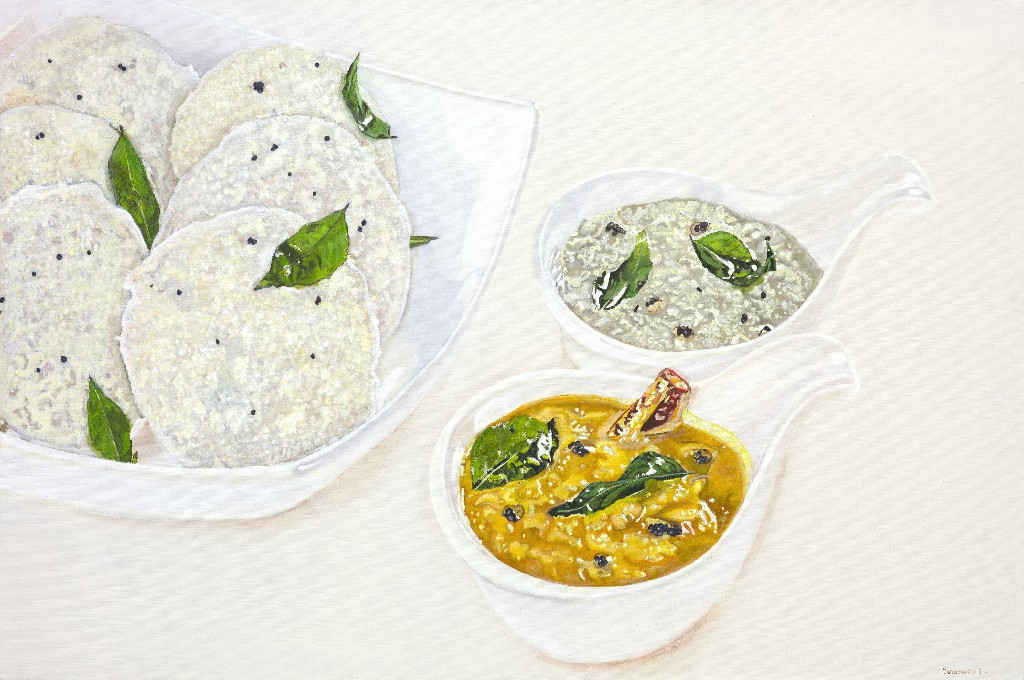 For years, this self-taught artist dabbled in various genres before Google introduced her to hyperrealism in 2015. The works of artists Tjalf Sparnaay and Mary Ellen Johnson fascinated her with their food paintings, in hyperrealist and mega realistic style. The intricate detail, the play of light, and the expansive view of objects as if magnified manifold, created a lasting impression. This led her to explore food as a motif and resulted in the current series, where she focuses on a plethora of Indian foods, specific to various regions across the country. She became passionate about depicting the wealth of traditional foods from different regions of India to highlight the social and ethnic significance of Indian cuisine and its diversity. The multifaceted detail, the play of light, and farreaching perspective on objects as though amplified complex, made an enduring impression on her mind which in result drove her to investigate food as a theme and content for her work. Soon she discovered that Indian food was very little investigated in this specific field hence, her excursion began. She believes that food always assumes a focal function in each culture, around the world, and what one cooks and consumes somehow represents one’s identity and origin. Her art originates from a love for Indian cuisines that invoke emotions and memories related to the image of the food and heighten all associated sensations. She finds that artworks representing Indian food are uncommon and rare in comparison to its popularity as a cuisine. Her paintings, hence, structure another approach to making social interfaces and accounts around Indian food and related narratives, both individual and natural. She paints on thrice-primed linen which lends life to the paintings because of its smoothness. Her paintings take so much time, patience and skill, for the texture to show up in the most real form. When zoomed in, the painting has hundreds and thousands of holes and lines that come together to finally combine up to a large enchanting and mouthwatering piece of work.
For years, this self-taught artist dabbled in various genres before Google introduced her to hyperrealism in 2015. The works of artists Tjalf Sparnaay and Mary Ellen Johnson fascinated her with their food paintings, in hyperrealist and mega realistic style. The intricate detail, the play of light, and the expansive view of objects as if magnified manifold, created a lasting impression. This led her to explore food as a motif and resulted in the current series, where she focuses on a plethora of Indian foods, specific to various regions across the country. She became passionate about depicting the wealth of traditional foods from different regions of India to highlight the social and ethnic significance of Indian cuisine and its diversity. The multifaceted detail, the play of light, and farreaching perspective on objects as though amplified complex, made an enduring impression on her mind which in result drove her to investigate food as a theme and content for her work. Soon she discovered that Indian food was very little investigated in this specific field hence, her excursion began. She believes that food always assumes a focal function in each culture, around the world, and what one cooks and consumes somehow represents one’s identity and origin. Her art originates from a love for Indian cuisines that invoke emotions and memories related to the image of the food and heighten all associated sensations. She finds that artworks representing Indian food are uncommon and rare in comparison to its popularity as a cuisine. Her paintings, hence, structure another approach to making social interfaces and accounts around Indian food and related narratives, both individual and natural. She paints on thrice-primed linen which lends life to the paintings because of its smoothness. Her paintings take so much time, patience and skill, for the texture to show up in the most real form. When zoomed in, the painting has hundreds and thousands of holes and lines that come together to finally combine up to a large enchanting and mouthwatering piece of work.
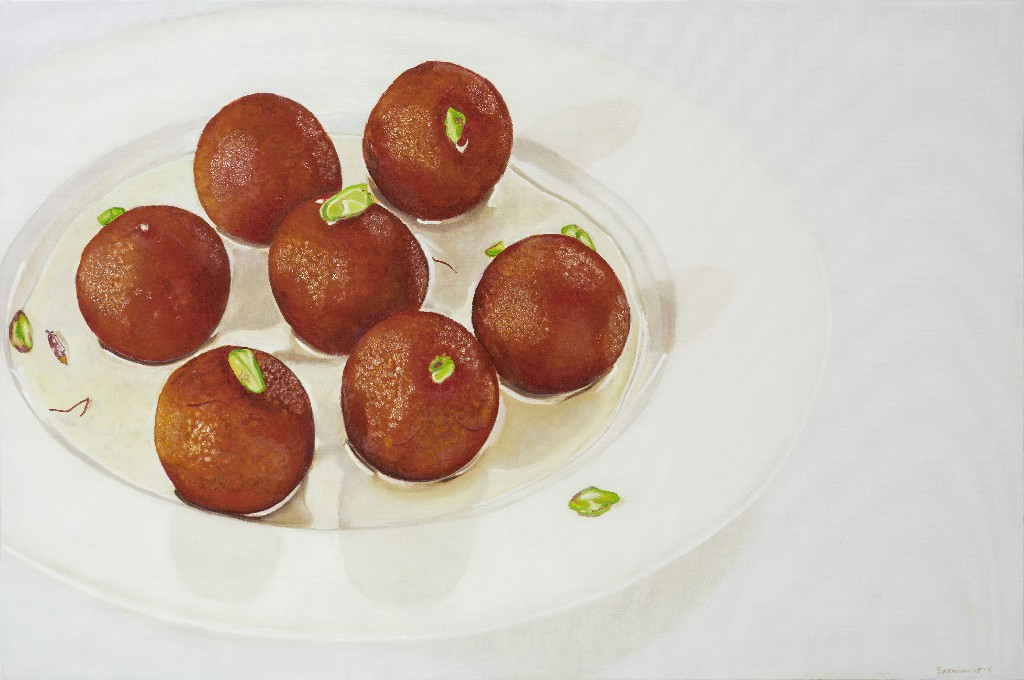 Sarasvathy’s adoration and energy for hyperrealism have landed her in different eminent displays and shows. She got an opportunity to exhibit her painting titled “Idli, Sambar and Coconut Chutney” at the “Cultural Heritage show WWAC ” New Jersey where her painting was also featured on the show’s invites. This followed her to her first museum exhibiting opportunity, as “Dosa and Sambar” was juried into “Salmagundi” an 1871 world-renowned Art gallery of New York whose members include Thomas Moran, Louis Comfort Tiffany, etc. She was also honored with membership by the “International Guild of Realism, US for her third series of the painting titled, “Samosa, Tamarind Chutney, and Coriander Chutney”. This was published in the April subscription of ‘American Art Collector’ April 2020 magazine which was a dream come true for the artist. Her fourth series “Garlic, Naan, and Coriander” also made her proud as she received an Award of Merit from the “American Women Artists Association”. On ‘World Idli Day’ which falls on March 30th, Sarasvathy delivered 22 customized US postage stamps of her painting ‘Idli Sambar and Coconut chutney’ as a recognition for all the food aficionados and her affection for the hyper realistic portrayal of craftsmanship. This was very much valued and appreciated by the art world alongside inclusion in ‘The Hindu Business line’. She is now preparing 11 works under her project titled ‘Bhojan’ for a solo exhibition in New York next year.
Sarasvathy’s adoration and energy for hyperrealism have landed her in different eminent displays and shows. She got an opportunity to exhibit her painting titled “Idli, Sambar and Coconut Chutney” at the “Cultural Heritage show WWAC ” New Jersey where her painting was also featured on the show’s invites. This followed her to her first museum exhibiting opportunity, as “Dosa and Sambar” was juried into “Salmagundi” an 1871 world-renowned Art gallery of New York whose members include Thomas Moran, Louis Comfort Tiffany, etc. She was also honored with membership by the “International Guild of Realism, US for her third series of the painting titled, “Samosa, Tamarind Chutney, and Coriander Chutney”. This was published in the April subscription of ‘American Art Collector’ April 2020 magazine which was a dream come true for the artist. Her fourth series “Garlic, Naan, and Coriander” also made her proud as she received an Award of Merit from the “American Women Artists Association”. On ‘World Idli Day’ which falls on March 30th, Sarasvathy delivered 22 customized US postage stamps of her painting ‘Idli Sambar and Coconut chutney’ as a recognition for all the food aficionados and her affection for the hyper realistic portrayal of craftsmanship. This was very much valued and appreciated by the art world alongside inclusion in ‘The Hindu Business line’. She is now preparing 11 works under her project titled ‘Bhojan’ for a solo exhibition in New York next year.
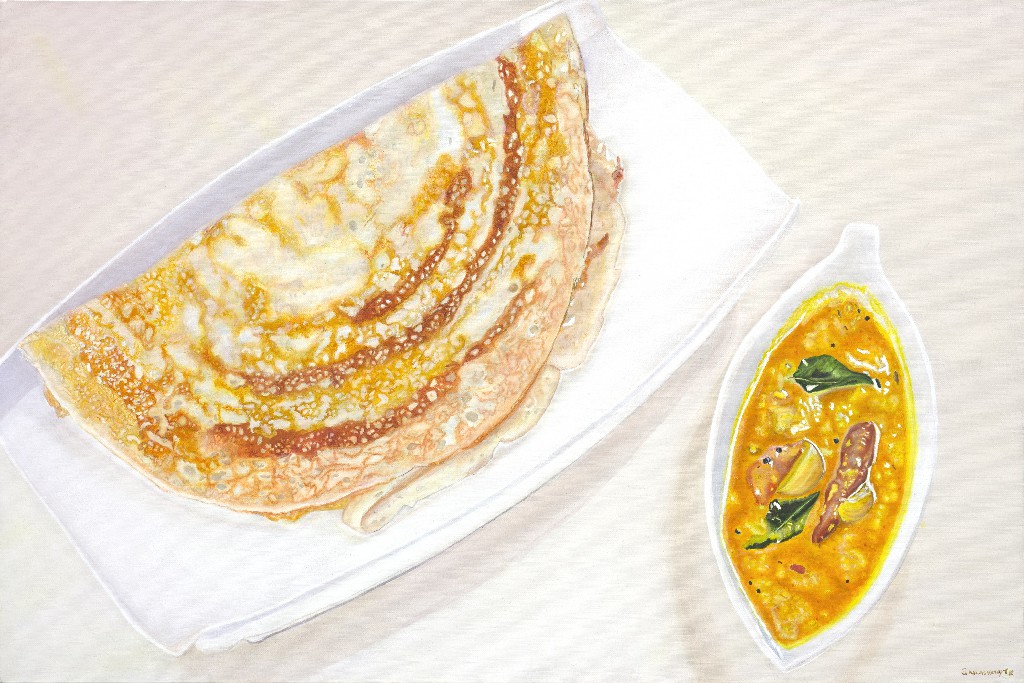 Food and recipes through generations have been preserved and kept alive with the help of knowledge and art. Sarasvathy’s journey not only waters and nourishes her passion for art but on the same hand opens up new gates for people to either indulge in Indian food or get carried away by the sweet memories of it. The amount of work and the detailed output covering color, texture, shape, condiments, magnitude, and depth in each painting shows her excellence and mastery in the field of hyper-realistic art. Through awe-inspiring manual dexterity and prowess, Sarasvathy creates a tangible solidity and physical presence. The details carry more clarity than in nature, thus providing us with an enhanced view of reality. Art hides both in the creative process and the finalized work, and the creative process of Hyperrealism is one of the most intricate ones in art. Sarasvathy’s work leaves the viewer with an ultimate stimulation and one of a kind of experience.
Food and recipes through generations have been preserved and kept alive with the help of knowledge and art. Sarasvathy’s journey not only waters and nourishes her passion for art but on the same hand opens up new gates for people to either indulge in Indian food or get carried away by the sweet memories of it. The amount of work and the detailed output covering color, texture, shape, condiments, magnitude, and depth in each painting shows her excellence and mastery in the field of hyper-realistic art. Through awe-inspiring manual dexterity and prowess, Sarasvathy creates a tangible solidity and physical presence. The details carry more clarity than in nature, thus providing us with an enhanced view of reality. Art hides both in the creative process and the finalized work, and the creative process of Hyperrealism is one of the most intricate ones in art. Sarasvathy’s work leaves the viewer with an ultimate stimulation and one of a kind of experience.
Pranamita Borgohain
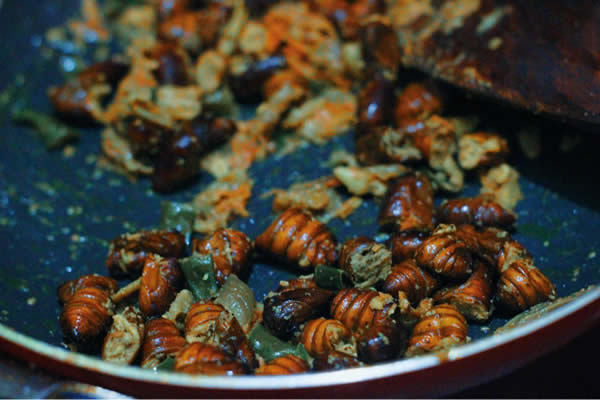 FACTS: The first silkworm was consumed by the Empress of China Xi Ling Shi when she discovered a cocoon thread in her cup of tea. In China and Vietnam, silkworms are fried and are very common delicacy. Even Koreans found it interesting when they first had cocoon as edible item now they describe this particular dish as (Peondegi).
FACTS: The first silkworm was consumed by the Empress of China Xi Ling Shi when she discovered a cocoon thread in her cup of tea. In China and Vietnam, silkworms are fried and are very common delicacy. Even Koreans found it interesting when they first had cocoon as edible item now they describe this particular dish as (Peondegi).




